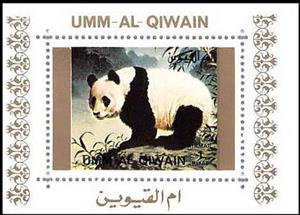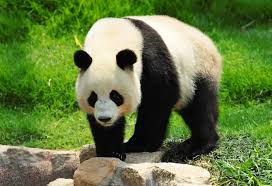Souvenir Sheet: Giant Panda (Ailuropoda melanoleuca) (Umm al-Qiwain 1972)
Giant Panda (Ailuropoda melanoleuca) (Umm al-Qiwain 1972)
01 January (Umm al-Qiwain ) within release Rare Animals (I), large format goes into circulation Souvenir Sheet Giant Panda (Ailuropoda melanoleuca) face value 1 Qatari riyal
| Souvenir Sheet Giant Panda (Ailuropoda melanoleuca) in catalogues | |
|---|---|
| Michel: | Mi: UM 1382AEBw |
| Colnect codes: | Col: UM 1972.00.00-271mb |
Souvenir Sheet is square format.
White frameAlso in the issue Rare Animals (I), large format:
- Stamp - Arabian Oryx (Oryx leucoryx) face value 1;
- Souvenir Sheet - Arabian Oryx (Oryx leucoryx) face value 1;
- Stamp - Black Rhinoceros (Diceros bicornis) face value 1;
- Souvenir Sheet - Black Rhinoceros (Diceros bicornis) face value 1;
- Stamp - Cheetah (Acinonyx jubatus) face value 1;
- Souvenir Sheet - Cheetah (Acinonyx jubatus) face value 1;
- Stamp - Eurasian Lynx (Lynx lynx) face value 1;
- Souvenir Sheet - Eurasian Lynx (Lynx lynx) face value 1;
- Stamp - Giant Panda (Ailuropoda melanoleuca) face value 1;
- Souvenir Sheet - Giant Panda (Ailuropoda melanoleuca) face value 1;
- Stamp - Indri (Indri indri) face value 1;
- Souvenir Sheet - Indri (Indri indri) face value 1;
- Stamp - Kudu face value 1;
- Souvenir Sheet - Kudu face value 1;
- Stamp - Onager (Equus hemionus onager) face value 1;
- Souvenir Sheet - Onager (Equus hemionus onager) face value 1;
- Stamp - Polar Bear (Ursus maritimus) face value 1;
- Souvenir Sheet - Polar Bear (Ursus maritimus) face value 1;
- Stamp - Przewalski’s Horse (Equus przewalskii) face value 1;
- Souvenir Sheet - Przewalski’s Horse (Equus przewalskii) face value 1;
- Mini Sheet - Rare Animals face value 16*1;
- Stamp - Sable Antelope (Hippotragus niger) face value 1;
- Souvenir Sheet - Sable Antelope (Hippotragus niger) face value 1;
- Stamp - Sea Lion face value 1;
- Souvenir Sheet - Sea Lion face value 1;
- Stamp - Tiger (Panthera tigris) face value 1;
- Souvenir Sheet - Tiger (Panthera tigris) face value 1;
- Stamp - Walrus (Odobenus rosmarus) face value 1;
- Souvenir Sheet - Walrus (Odobenus rosmarus) face value 1;
- Souvenir Sheet - Walrus (Odobenus rosmarus) face value 1;
- Stamp - Wild Bactrian Camel (Camelus ferus) face value 1;
- Souvenir Sheet - Wild Bactrian Camel (Camelus ferus) face value 1;
- Stamp - Zebra (Equus sp.) face value 1;
- Souvenir Sheet - Zebra (Equus sp.) face value 1;
Souvenir Sheet Giant Panda (Ailuropoda melanoleuca) it reflects the thematic directions:
Animals are multicellular, eukaryotic organisms of the kingdom Animalia (also called Metazoa). All animals are motile, meaning they can move spontaneously and independently, at some point in their lives. Their body plan eventually becomes fixed as they develop, although some undergo a process of metamorphosis later on in their lives. All animals are heterotrophs: they must ingest other organisms or their products for sustenance.
Bears are carnivoran mammals of the family Ursidae (/ˈɜːrsɪdiː, -daɪ/). They are classified as caniforms, or doglike carnivorans. Although only eight species of bears are extant, they are widespread, appearing in a wide variety of habitats throughout most of the Northern Hemisphere and partially in the Southern Hemisphere. Bears are found on the continents of North America, South America, and Eurasia. Common characteristics of modern bears include large bodies with stocky legs, long snouts, small rounded ears, shaggy hair, plantigrade paws with five nonretractile claws, and short tails.
Mammals are any vertebrates within the class Mammalia (/məˈmeɪli.ə/ from Latin mamma "breast"), a clade of endothermic amniotes distinguished from reptiles (including birds) by the possession of a neocortex (a region of the brain), hair, three middle ear bones and mammary glands. All female mammals nurse their young with milk, secreted from the mammary glands. Mammals include the largest animals on the planet, the great whales. The basic body type is a terrestrial quadruped, but some mammals are adapted for life at sea, in the air, in trees, underground or on two legs. The largest group of mammals, the placentals, have a placenta, which enables the feeding of the fetus during gestation. Mammals range in size from the 30–40 mm (1.2–1.6 in) bumblebee bat to the 30-meter (98 ft) blue whale. With the exception of the five species of monotreme (egg-laying mammals), all modern mammals give birth to live young. Most mammals, including the six most species-rich orders, belong to the placental group. The largest orders are the rodents, bats and Soricomorpha (shrews and allies). The next three biggest orders, depending on the biological classification scheme used, are the Primates (apes and monkeys), the Cetartiodactyla (whales and even-toed ungulates), and the Carnivora (cats, dogs, seals, and allies).
The giant panda (Ailuropoda melanoleuca), also known as the panda bear or simply panda, is a bear species endemic to China. It is characterised by its white coat with black patches around the eyes, ears, legs and shoulders. Its body is rotund; adult individuals weigh 100 to 115 kg (220 to 254 lb) and are typically 1.2 to 1.9 m (3 ft 11 in to 6 ft 3 in) long. It is sexually dimorphic, with males being typically 10 to 20% larger than females. A thumb is visible on its forepaw, which helps in holding bamboo in place for feeding. It has large molar teeth and expanded temporal fossa to meet its dietary requirements. It can digest starch and is mostly herbivorous with a diet consisting almost entirely of bamboo and bamboo shoots.




